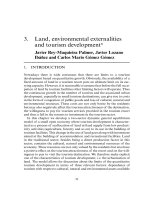THE ECONOMICS OF MONEY,BANKING, AND FINANCIAL MARKETS 470
Bạn đang xem bản rút gọn của tài liệu. Xem và tải ngay bản đầy đủ của tài liệu tại đây (50.62 KB, 1 trang )
438
PA R T V
Central Banking and the Conduct of Monetary Policy
Desired reserves are insurance against deposit outflows, and the cost of holding these reserves is their opportunity cost, the interest rate that could have been
earned on lending these reserves out, which is the overnight interest rate. Thus,
as the overnight interest rate decreases, the opportunity cost of holding desired
reserves falls and, holding everything else constant, the quantity of reserves
demanded rises. Consequently, the demand curve for reserves, R d, slopes downward in Figure 17-2.
Supply Curve
The Bank of Canada s standing liquidity facilities (lending and deposit facilities)
define an effective supply curve for settlement balances, shown in Figure 17-2. In
particular, with a standing lending facility, the Bank of Canada does not limit the
amount of borrowing by banks, but always stands ready to make collateralized
overdraft loans (advances) at the lending rate, ib. Thus the quantity of reserves supplied is flat (infinitely elastic) at ib , as shown in Figure 17-2, because if the
overnight interest rate, denoted by ior , begins to rise above ib , banks would just
keep borrowing from the Bank of Canada indefinitely.
On the other hand, the Bank of Canada s deposit facility pays banks a fixed
interest rate, ib 0.50 on any reserves (deposits) they would like to keep at the Bank
of Canada. The quantity of reserves supplied is also flat at ib 0.50, because if the
overnight rate begins to fall below this rate, banks would not lend in the overnight
market. Instead, they would keep increasing the amount of their deposits in the
Bank of Canada (effectively lending to the Bank of Canada), and would thereby
keep lowering the quantity of reserves the Bank of Canada is supplying.
In between ib 0.50 and ib , banks will not borrow from the Bank of Canada
and borrowed reserves (BR) will be zero, because borrowing in the overnight market is cheaper. Thus, between ib 0.50 and ib , the quantity of reserves supplied
Overnight Interest
Rate, i or
Rs
Bank Rate, i b
*
i or
ib
R 2d
0.50
Rd
R 1d
NBR
F I G U R E 17- 2
Quantity of
Reserves, R
Equilibrium in the Market for Reserves in the Channel/Corridor System
for Setting the Overnight Interest Rate
In the channel/corridor system, standing liquidity facilities result in a step function supply
curve, R s. Equilibrium occurs at the intersection of the supply curve R s and the demand curve
R d at an interest rate of i*or.Then if the demand curve shifts between R d1 and R d2 , the overnight
interest rate ior always remains between ib 0.50 and ib.









